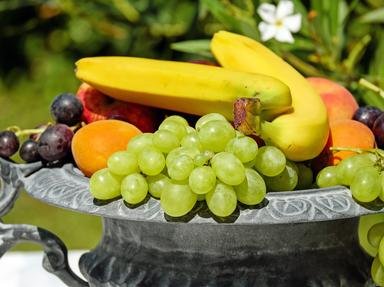Quiz Answer Key and Fun Facts
1. Cherries graced the tables of Chinese nobleman and Roman conquerors. This zippy little fruit was brought over to the new world (America) sometime during the 1600s. The cherry ranges in taste from sweet to tart. Over 650 millions pounds of sweet and tart variety cherries are grown and harvested each year in the United States, but do you know where the National Cherry Festival is held each year?
2. The coconut is a member of the palm family (Arecaceae) and is named such because the fruit comes from the coconut palm. While the coconut does not really contain "nuts", it is a dry fruit known as fibrous drupe. The inner part of the coconut is filled with "coconut water" and is high in potassium, chloride, and calcium. Now that you know a bit more about the coconut, can you tell me which of the following is home to the oldest coconut palm tree fossil?
3. The medlar resembles an apple, but is approximately two or three centimeters in diameter. Medlars are extremely hard when ripe, and it is best to wait at least a week or two after harvesting to eat this tiny fruit. The medlar was a popular fruit during Roman and Medieval times. Now can you tell me in which year the medlar tree was brought to Greece?
4. The word pawpaw is a derivative of the Spanish word papaya. While both pawpaw and papaya trees look similar their fruit does not taste the same. The pawpaw has a taste combination of a banana and a mango, while the papaya tastes similar to a cantaloupe. But which country uses the name pawpaw for the papaya fruit?
5. The kiwifruit tastes like a combination of a strawberry, banana, and a pineapple. The kiwifruit's history can be traced back to China where it was originally called the wild gooseberry. In 1959, New Zealand began producing wild gooseberries commercially and during that same year gave it the new name of kiwi. The kiwi is named for which of the following?
6. At first glance the quince looks like a pear, but upon inspecting it further one will notice the mottled skin, the lumpy appearance and if you dare to cut into it, you will soon find out how sour it really is. So why was the quince grown you ask? Well, it is one of the best fruits used for making marmalades, jams, and jellies. Columella, an ancient naturalist gave three "referring" names to the quince. Which of the following is not a name that Columella used?
7. The scientific name of the apricot is prunus armeniaca. However,even though its scientific name reflects the name Armenia, the stone fruit does not originate there. The apricot's history can be traced back to Northeastern China close to the Russian border. According to the "cots" history it did not touch down in Armenia for about three-thousand years! The apricot was brought to Europe about 70 BC. The English considered the "cot" an aphrodisiac. To the Chinese the fruit is a symbol for ____________.
8. While the banana in actuality is an herb, it is listed in the "Fruit and Vegetable Blue Book" as a fruit because it is harvested from trees and grows in stems or hands as the industry refers to them. A single stem of bananas can weigh as much as 100 pounds (45 kg), and is usually carried on the shoulders. The sections sold in supermarkets or at road side stands are part of the original stem of bananas. However, the skin of this delicious fruit came into question during the 1960s and 1980s. Legend has it that the banana skin is a hallucinogenic when smoked. In 1967, a student newspaper called the Berkeley Barb published a story regarding the banana skin's "freaky" qualities, but which singer did the Berkeley Barb get the story from?
9. The star fruit, or paopu as it is known in China, has a sweet, mild, sub-acid taste. It is best to eat the star fruit fresh as its pulp does not store well. When you cut the fruit in slices it looks as its name suggests like a star, and is great to eat fresh or for salad decorations. But what about the seeds? Hmm...well with some fruit you can eat the seeds and others you cannot. What can be made from the star fruit's seeds?
10. The miracle fruit is native to West Africa. The tree cannot be grown in the USA except in one place, Southern Florida, where the climate is similar to that of the tree's homeland. The fruit that grows on the tree is small like a berry and is almost tasteless, with one amazing effect. Which of the following will happen if you eat the miracle fruit?
Source: Author
JuniorTheJaws
This quiz was reviewed by FunTrivia editor
ozzz2002 before going online.
Any errors found in FunTrivia content are routinely corrected through our feedback system.

